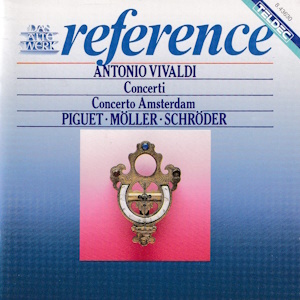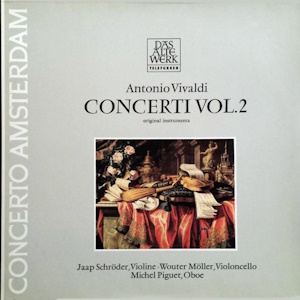 |
| 1 CD -
8.43630 ZS - (c) 1987 |
 |
1 LP -
6.42355 AW - (p) 1978
|
|
CONCERTI VOL. 2
|
|
|
|
|
|
|
|
|
|
| Antonio
VIVALDI (1678-1741) |
Concerto
D-dur für Violine, Streicher und
Cembalo "Il grosso Mogul" (Der
Großmogul), F I/138 |
* |
|
13' 58" |
|
|
|
- Allegro (Kadenz:
Jaap Schröder)
|
|
6' 02" |
|
1 |
A1
|
|
- Grave.
Recitativo
|
|
3' 12" |
|
2 |
A2
|
|
- Allegro (Kadenz:
Jaap Schröder)
|
|
4' 44" |
|
3 |
A3
|
|
Sinfonia
h-moll für Streicher "Al S.
Sepolcro", F XI/7 |
|
|
3' 23" |
|
|
|
-
Adagio
|
|
1' 56" |
|
4 |
A4
|
|
- Allegro, ma poco
|
|
1' 27" |
|
5 |
A5
|
|
Concerto
h-moll für Violoncello, Streicher
und Cembalo, F III/9 |
** |
|
10' 25" |
|
|
|
- Allegro non
molto
|
|
4' 12" |
|
6 |
A6
|
|
- Largo
|
|
2' 37" |
|
7 |
A7
|
|
-
Allegro
|
|
3' 36" |
|
8 |
A8 |
|
Concerto
a-moll für Oboe, Streicher und
Cembalo, F VII/5 |
*** |
|
8' 38" |
|
|
|
-
Allegro non molto |
|
3' 47" |
|
9 |
B1 |
|
-
Larghetto |
|
2' 15" |
|
10 |
B2 |
|
- Allegro
|
|
2' 35" |
|
11 |
B3 |
|
Sinfonia
a 4 in Es-dur für 2 Violinen,
Viola und B.c. "Al Santo
sepolcro", F XVI/2 |
|
|
3' 53" |
|
|
|
- Largo molto
|
|
2' 10" |
|
12 |
B4 |
|
- Allegro, ma poco
|
|
1' 43" |
|
13 |
B5 |
|
Concerto
c-moll für Oboe, Violine,
Streicher und Cembalo, F XII/53 |
*/*** |
|
7' 03" |
|
|
|
- Adagio
|
|
2' 25" |
|
14 |
B6 |
|
- Allegro
|
|
1' 55" |
|
15 |
B7 |
|
- Adagio |
|
1' 10" |
|
16 |
B8 |
|
- Allegro |
|
1' 43" |
|
17 |
B9 |
|
|
|
|
|
Jaap
Schröder, Violine *
|
CONCERTO AMSTERDAM
(mit Originalinstrumenten)
|
Wouter Möller,
Violoncello **
|
- Michel Piguet,
Oboe
|
Michel Piguet,
Oboe ***
|
- Jaap Schröder,
Violine
|
|
- Ruth Hesseling,
Violine
|
|
- Alda Stuurop,
Violine
|
|
- Antoinette van
den Homnergh, Violine
|
|
- Linda Ashworth,
Viola
|
|
- Wouter Möller,
Violoncello
|
|
- Lidewy Scheifes,
Violoncello (Continuo in Cellokonzert)
|
|
- Jeroen van der
Linden, Violone |
|
- Bob van Asperen,
Violoncello |
|
Jaap SCHRÖDER,
Konzertmeister |
|
|
|
|
Luogo
e data di registrazione |
|
Doopsgezinde
Kerk, Haarlem (Netherlands)
|
|
|
Registrazione:
live / studio |
|
studio |
|
|
Producer |
|
Heinrich
Weritz
|
|
|
Prima Edizione
LP |
|
Telefunken
- 6.42355 AW - (1 LP) - durata 47'
20" - (p) 1978 - Analogico
|
|
|
Edizione
"Reference" CD
|
|
Tedec
- 8.43630 ZS - (1 CD) - LC 3706 -
durata 47' 20" - (c) 1987 - AAD |
|
|
Cover |
|
Foto mit
freundlicher Genehmigung des
Museums für Kunst und Gewerbe
Hamburg |
|
|
Note |
|
-
|
|
|
|
|
Antonio
Vivaldi’s significance
as a composer is
scarcely in doubt any
longer: after all, few
musicians have staged
such an impressive
comeback as the prete
rosso, or Red
Priest, as Vivaldi was
known on account of the
colour of his hair. Yet
the rediscovery of the
works of Venice‘s most
famous maestro di
violino, about
whose turbulent life the
dramatist Carlo Goldoni
reports briefly in his
memoirs (Goldoni valued
him more as a virtuoso
violinist than as a
composer), began
inauspiciously, with
many of his concertos,
which are all of a
similar basic type,
eliciting little
interest or even
outright rejection. To
quote Walter Kolneder,
“it was the composers
least substantial works
that most incensed
Vivaldi‘s critics". It
was only when audiences
became acquainted with
many of his other
pieces, including the
programmatical Le
quattro stagioni
(Four Seasons) from Il
cimento dell'armonia e
dell’inventione
op. 8, written around
1725, as well as a
number of the composers
operas and sacred Works,
that this picture was
finally corrected.
The Violin Concerto in D
major, RV 208 is also
known as Il grosso
Mogul, a title
which, probably intended
as a joke, is found in
only a single copy.
Delightful though this
name may be, the work
itself is one of the
least well known of
Vivaldi’s many violin
concertos. The opening
Allegro is thematically
simple but virtuoso in
style, and is followed
by a recitative-like
slow movement in the
relative (Vivaldi was
particularly fond of B
minor), with a deeply
expressive melodic line.
The final Allegro is
dance-like in character.
The Work is notable not
least for the fact that
the solo instrument is
supported either by the
continuo alone or by a
loose accompaniment of
tutti violins.
Whether the Sinfonia in
B minor, RV 169 should
be accounted a concerto
or an example of
programme music must
remain an open question.
Its nickname Al
Santa Sepolcro
refers to the tradition
of reproducing the Holy
Sepulchre in churches
during Holy Week.
Vivaldi’s predilection
for chromatic writing,
the anguished and solemn
mood of the opening
section (Adagio molto)
and the thematic
reminiscences of the
Adagio molto in the
second section (Allegro,
ma poco) go far beyond
the average concertante
writing of many similar
works.
Also in B minor is the
Cello Concerto, RV 424.
Of Vivaldi's
twenty-seven works for
the instrument this is
one of the least well
known. The composer's
remarkable command of
cello technique and the
nature of the writing
for an instrument still
in the early stages of
its development may be
attributable to his
acquaintance with the
Italian cellist
Francischello. The heart
of this three-movement
work is its central
panel, a Largo which,
although only sixteen
bars long, is notable
for the way in which a
simple idea is richly
ornamented, while at the
same time affording an
oasis of calm. The
virtuoso demands placed
on the solo instrument
in the final Allegro are
even more formidable
than those found in the
opening movement. “With
the exception of a
handful of weaker
pieces," Walter Kolneder
writes, Vivaldi’s cello
concertos are “of the
highest musical quality.
In the technical demands
that they place upon
their performer, they
reflect the most
important stage in the
history of the
instrument and the
manner in which it is
played".
Vivaldi wrote a total of
twenty concertos for
solo oboe, strings and
harpsichord. According
to Kolneder, the Oboe
Concerto in A minor, RV
461 may have been
inspired by the high
level of woodwind
playing at the courts of
the Landgrave of
Hesse-Darmstadt, the
Duke of Lorraine and
Count Morzin of Bohemia
and is a particularly
fine example of
Vivaldi’s inventive
skill at writing for a
concertante solo
instrument. The opening
Allegro non molto will
surprise the listener
with its rhythmic
vitality and
succinctness of
expression, while the
following Larghetto in C
major exploits the
Scotch snap, a
syncopated figuration
very popular in its day.
Except in the opening
and closing bars of the
tutti, the orchestra is
limited to violins and
viola, which provide the
soloist with modest
support. In the final
Allegro, as in so many
other concertos by
Vivaldi, it is the
concertante style that
predominates. As in the
previous concerto, this
final movement places
greater technical
demands on the soloist
than the opening
Allegro.
Like the B minor
Sinfonia, the Sonata in
E flat major for two
violins, viola and
continuo, RV 130 has the
alternative title of Al
Santo Sepolcro.
It, too, is in two
movements, a Largo molto
and Allegro, ma poco,
that are stylistically
similar to some of the
early works of Viennese
Classicism. Indeed, many
of the features of
Vivaldi’s concertos or
sinfonias (the two terms
were used more or less
interchangeably by the
composer) anticipate a
development that was
later to find expression
in the Classical
bithematic sonata. A
model of self-contained
unity, the sonata’s
second movement is a
fine example of this
technique.
Manuscripts and copies
of Vivaldi’s
instrumental works have
been found in a number
of North European
libraries in recent
decades. The Concerto in
C minor, RV app.17 for
oboe and violin was
discovered in Lund
(Sweden) and published
by David Lasocki in
1973. Cast in the form
of a sonata da
chiesa, it may
remind its listeners, at
least at an initial
hearing, of a concerto
by Corelli or Handel.
Particularly noteworthy
is the urgency of the
second movement
(Allegro) and, as so
often with Vivaldi, the
hannonic sophistication
of the Adagio in G
minor, which serves, so
to speak, as a
dominant-key
introduction to the
gigue-like final
movement.
Helmuth
Wirths
Translation:
Stewart Spencer
|
|